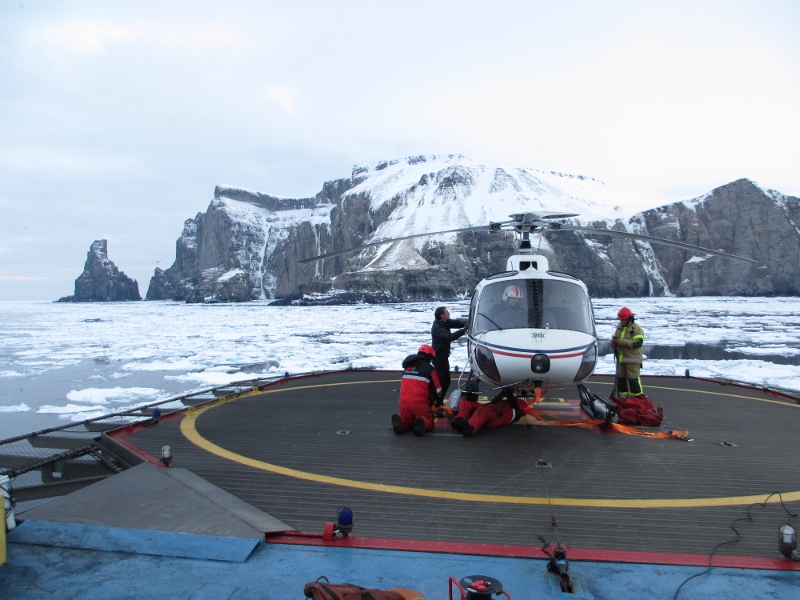Key site Bjørnøya
Bjørnøya is located midway between mainland Norway and Spitsbergen. The island is the southernmost point of the Svalbard archipelago, and appears as a small and isolated island in the midst of a large sea area. Seabirds occur in huge numbers on Bjørnøya, and monitoring started here in 1986. Contact person: Hallvard Strøm, Norwegian Polar Institute
Location and description

Photo: Sebastian Gerland
Bjørnøya is 20 km long and 15.5 km wide, with a total area of 178 km². The landscape has two distinct forms. In the north and west you will find a flat plain, mostly 30-40 m a.s.l., covered with about 750 small and larger lakes. The smaller part (about 1/3 of the island) in the south and east consists of mountains up to a height of 536 m (Miseryfjell). The renowned bird cliffs that reach 400 m a.s.l. are at the south end of the island.
Bjørnøya’s strategic location (74° 26’N, 19° 02’E) in the midst of the most productive part of the Barents Sea forms the basis for the large numbers of seabirds. As the only island in a large and rich sea area, Bjørnøya acts as a magnet to seabirds during the breeding season. Several species find food up to and beyond 100 kilometers from the colony. Around Bjørnøya, the Polar Front is a particularly important foraging area. The Polar Front usually surrounds the island on the west, south and east. The ice edge is also an important area for food for several species in spring and early summer, before the ice retreats to the northern parts of the Barents Sea. The geology and topography of the island also help to make the island an attractive breeding site. The mountainous south of the island consists of dolomite limestone. This sedimentary rock forms countless shelves in the huge cliff faces.
Access
There are limited opportunities for getting to and from such a deserted island as Bjørnøya. At the meteorological station at the north end of the island there is a single quay, but only small boats can use this. There are otherwise several beaches around the island that can be used as landing points for small boats. A helicopter is nevertheless the most common means of transport for those who work at the weather station and for SEAPOP’s field workers. People and equipment are flown from ships or come directly from Longyearbyen or the mainland, although good landing conditions are not guaranteed. Fog around Bjørnøya can make flights difficult. Instead, you have to land in a small boat and carry equipment and supplies to the workplaces located in different places on the island.
Wildlife
Seabirds dominate animal and bird life on Bjørnøya. They nest on the cliffs around the entire island, but the colonies around the southern tip are especially large. The seabird community on Bjørnøya is dominated by five species. These are common Uria aalge and Brünnich’s guillemots U. lomvia, kittiwakes Rissa tridactyla, fulmars Fulmarus glacialis and glaucous gulls Larus hyperboreus. In addition, great black-backed gulls L. marinus, arctic terns Sterna paradisaea, Northern gannets Morus bassanus, great skuas Stercorarius skua, puffins Fratercula arctica, black guillemots Cepphus grylle, razorbills Alca torda and little auks Alle alle nest on the island. Bjørnøya is one of very few seabird colonies in the Atlantic Ocean where all six Atlantic auks (common, Brünnich’s and black guillemot, razorbill, puffin and little auk) co-exist in significant numbers. Brünnich’s guillemot and little auk are Arctic species, which in Svalbard and the Barents Sea have their southernmost colonies on Bjørnøya. Common guillemots and razorbills, on the other hand, are southern species that have their northernmost occurrence on Bjørnøya. Only a few other places in the world do we find Brünnich’s and common guillemots nesting side by side in such large numbers. The gannet established itself as a breeding species in 2011.
Human activity
Bjørnøya was designated as a nature reserve in 2002 to protect the large seabird populations and the unique and magnificent landscape. The protection encompasses the entire island except for a small area around the meteorological station that is run by a crew of nine people all year round. It also includes the marine areas out to four nautical miles from the coast. As part of the protection, access is banned in the most vulnerable parts of the large seabird colonies in the south of the island and in an area around Lomvatnet in the north, this for the sake of the great northern diver.
Fieldwork
The fact that Bjørnøya constitutes a meeting place between northern and southern species makes the island an interesting research platform. The number and availability of seabirds are also unique. While most of the bird cliffs in Svalbard are steep, inaccessible and partly susceptible to avalanches, the topography on Bjørnøya allows one to get close to the birds. This applies especially to the fulmar and the common and Brünnich’s guillemot. This makes possible studies of these species that elsewhere would be difficult or impossible. Easy access was also an important factor for egg harvesting, which was previously carried out in excess on Bjørnøya.


